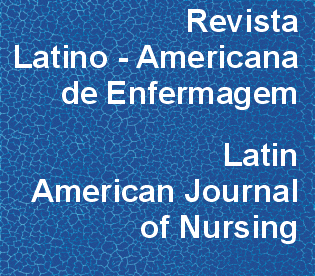Perfil obstétrico de adolescentes embarazadas en un hospital público: riesgo al inicio del trabajo de parto, parto, posparto y puerperio
DOI:
https://doi.org/10.1590/0104-1169.0316.2621Resumen
Objetivo: escribir el perfil obstétrico de las adolescentes al inicio del trabajo de parto, durante el parto, el posparto y el puerperio.Método: estudio descriptivo transversal, con 85 adolescentes embarazadas elegidas por conveniencia, referidas de los Centros de Salud a un Hospital Público en la Ciudad de México. Fue evaluado el riesgo antes, durante, después del parto y en el puerperio, medidos respectivamente con los "Previgenes" que componen el Sistema de Evaluación de Riesgo Reproductivo y Perinatal.Resultados: el nivel socioeconómico, la ocupación y la escolaridad influyeron en la emotividad de las adolescentes ante el trabajo de parto, cuyo riesgo obstétrico fue de 55% bajo, 35% medio y 10% alto. El riesgo en el parto fue bajo en 55%, medio en 18% y alto en 27%. El riesgo en el posparto fue 50% riesgo bajo, 25% riesgo medio y 25% riesgo alto. En el puerperio, la mayoría de las adolescentes (90%) presentó riesgo bajo.Conclusión: la mayoría de las adolescentes presentaron bajo riesco en las etapas avaluadas. El estudio contribuyó a identificar las estrategias para el abordaje de riesgos por la vulnerabilidad propia en este tipo de población y favoreció la realización de intervenciones acorde a sus necesidades.Descargas
Descargas
Publicado
2015-10-01
Número
Sección
Artículos Originales
Licencia
Los derechos de autor son propiedad exclusiva de la Revista Latino-Americana de Enfermagem (RLAE), transferidos a través de la Declaración de Transferencia de Derechos de autor (que está en el formulario individual de declaración) firmada por los autores. Para el uso de artículos, RLAE adopta la Licencia Creative Commons CC BY-NC atribución no comercial (abstracto o código completo de licencia). Con esta licencia es permitido acceder, descargar (download), copiar, imprimir, compartir, reutilizar y distribuir los artículos, desde que para uso no comercial y con citación de la fuente, dando los créditos de autor a la Revista Latino-Americana de Enfermagem. En tales casos, no se necesita permiso de los autores o editores.Cómo citar
Perfil obstétrico de adolescentes embarazadas en un hospital público: riesgo al inicio del trabajo de parto, parto, posparto y puerperio . (2015). Revista Latino-Americana De Enfermagem, 23(5), 829-836. https://doi.org/10.1590/0104-1169.0316.2621



